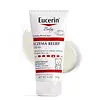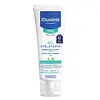What's inside
What's inside
 Key Ingredients
Key Ingredients

 Benefits
Benefits

 Concerns
Concerns

 Ingredients Side-by-side
Ingredients Side-by-side

Colloidal Oatmeal 1%
AbsorbentWater
Skin ConditioningGlycerin
HumectantRicinus Communis Seed Oil
MaskingParaffinum Liquidum
EmollientCetyl Alcohol
EmollientGlyceryl Stearate
EmollientCaprylic/Capric Triglyceride
MaskingOctyldodecanol
EmollientCetyl Palmitate
EmollientPEG-40 Stearate
EmulsifyingGlycyrrhiza Inflata Root Extract
Skin ConditioningCeramide NP
Skin Conditioning1,2-Hexanediol
Skin ConditioningPhenoxyethanol
PreservativePiroctone Olamine
PreservativeCaprylyl Glycol
EmollientEthylhexylglycerin
Skin ConditioningBenzyl Alcohol
PerfumingCitric Acid
BufferingColloidal Oatmeal 1%, Water, Glycerin, Ricinus Communis Seed Oil, Paraffinum Liquidum, Cetyl Alcohol, Glyceryl Stearate, Caprylic/Capric Triglyceride, Octyldodecanol, Cetyl Palmitate, PEG-40 Stearate, Glycyrrhiza Inflata Root Extract, Ceramide NP, 1,2-Hexanediol, Phenoxyethanol, Piroctone Olamine, Caprylyl Glycol, Ethylhexylglycerin, Benzyl Alcohol, Citric Acid
Water
Skin ConditioningPropanediol Dicaprylate
EmollientC10-18 Triglycerides
EmollientGlycerin
HumectantTriisostearin
Skin ConditioningGlyceryl Stearate Citrate
EmollientRicinus Communis Seed Oil
MaskingButyrospermum Parkii Butter
Skin ConditioningHelianthus Annuus Seed Oil Unsaponifiables
Emollient1,2-Hexanediol
Skin ConditioningCetyl Alcohol
EmollientPolyacrylate Crosspolymer-6
Emulsion StabilisingSodium Stearoyl Glutamate
CleansingGlyceryl Caprylate
EmollientHydrogenated Castor Oil
EmollientSodium Citrate
BufferingCitric Acid
BufferingDipotassium Glycyrrhizate
HumectantTocopherol
AntioxidantPersea Gratissima Fruit Extract
EmollientCeramide NP
Skin ConditioningPhytosphingosine
Skin ConditioningWater, Propanediol Dicaprylate, C10-18 Triglycerides, Glycerin, Triisostearin, Glyceryl Stearate Citrate, Ricinus Communis Seed Oil, Butyrospermum Parkii Butter, Helianthus Annuus Seed Oil Unsaponifiables, 1,2-Hexanediol, Cetyl Alcohol, Polyacrylate Crosspolymer-6, Sodium Stearoyl Glutamate, Glyceryl Caprylate, Hydrogenated Castor Oil, Sodium Citrate, Citric Acid, Dipotassium Glycyrrhizate, Tocopherol, Persea Gratissima Fruit Extract, Ceramide NP, Phytosphingosine
Ingredients Explained
These ingredients are found in both products.
Ingredients higher up in an ingredient list are typically present in a larger amount.
1,2-Hexanediol is a synthetic liquid and another multi-functional powerhouse.
It is a:
- Humectant, drawing moisture into the skin
- Emollient, helping to soften skin
- Solvent, dispersing and stabilizing formulas
- Preservative booster, enhancing the antimicrobial activity of other preservatives
Ceramide NP is a type of ceramide and formally known as ceramide 3.
Ceramides are intercellular lipids naturally found in our skin that bonds dead skin cells together to create a barrier. They are known for their ability to hold water and thus are a great ingredient for dry skin.
Ceramides are an important building block for our skin barrier. A stronger barrier helps the skin look more firm and hydrated. By bolstering the skin ceramides act as a barrier against irritating ingredients. This can help with inflammation as well.
If you would like to eat ceramides, sweet potatoes contain a small amount.
Read more about other common types of ceramides here:
Ceramide AP
Ceramide EOP
Cetyl Alcohol is a fatty alcohol. Fatty Alcohols are most often used as an emollient or to thicken a product.
Its main roles are:
Though it has "alcohol" in the name, it is not related to denatured alcohol or ethyl alcohol.
The FDA allows products labeled "alcohol-free" to have fatty alcohols.
Learn more about Cetyl AlcoholCitric Acid is an alpha hydroxy acid (AHA) naturally found in citrus fruits like oranges, lemons, and limes.
Like other AHAs, citric acid can exfoliate skin by breaking down the bonds that hold dead skin cells together. This helps reveal smoother and brighter skin underneath.
However, this exfoliating effect only happens at high concentrations (20%) which can be hard to find in cosmetic products.
Due to this, citric acid is usually included in small amounts as a pH adjuster. This helps keep products slightly more acidic and compatible with skin's natural pH.
In skincare formulas, citric acid can:
While it can provide some skin benefits, research shows lactic acid and glycolic acid are generally more effective and less irritating exfoliants.
Most citric acid used in skincare today is made by fermenting sugars (usually from molasses). This synthetic version is identical to the natural citrus form but easier to stabilize and use in formulations.
Read more about some other popular AHA's here:
Learn more about Citric AcidGlycerin is already naturally found in your skin. It helps moisturize and protect your skin.
A study from 2016 found glycerin to be more effective as a humectant than AHAs and hyaluronic acid.
As a humectant, it helps the skin stay hydrated by pulling moisture to your skin. The low molecular weight of glycerin allows it to pull moisture into the deeper layers of your skin.
Hydrated skin improves your skin barrier; Your skin barrier helps protect against irritants and bacteria.
Glycerin has also been found to have antimicrobial and antiviral properties. Due to these properties, glycerin is often used in wound and burn treatments.
In cosmetics, glycerin is usually derived from plants such as soybean or palm. However, it can also be sourced from animals, such as tallow or animal fat.
This ingredient is organic, colorless, odorless, and non-toxic.
Glycerin is the name for this ingredient in American English. British English uses Glycerol/Glycerine.
Learn more about GlycerinRicinus Communis Seed Oil is the INCI name for castor oil.
Castor Oil helps moisturize the skin. It is rich in a fatty acid called ricinoleic acid. This fatty acid helps prevent moisture loss on the skin. This helps keep your skin soft and hydrated. Ricinoleic acid also has anti-inflammatory and pain reducing properties.
Besides hydrating the skin, castor oil is also used to hydrate hair. By keeping the hair shaft moisturized, breakage is decreased. More studies are needed to show castor oil's effective on stimulating hair growth.
Castor oil is created by cold-pressing castor seeds and then purifying the oil with heat. It was used in Ancient Egypt as fuel in lamps and to help treat eye irritation.
The term 'fragrance' is not regulated in many countries. In many cases, it is up to the brand to define this term. For instance, many brands choose to label themselves as "fragrance-free" because they are not using synthetic fragrances. However, their products may still contain ingredients such as essential oils that are considered a fragrance.
Learn more about Ricinus Communis Seed OilWater. It's the most common cosmetic ingredient of all. You'll usually see it at the top of ingredient lists, meaning that it makes up the largest part of the product.
So why is it so popular? Water most often acts as a solvent - this means that it helps dissolve other ingredients into the formulation.
You'll also recognize water as that liquid we all need to stay alive. If you see this, drink a glass of water. Stay hydrated!
Learn more about Water